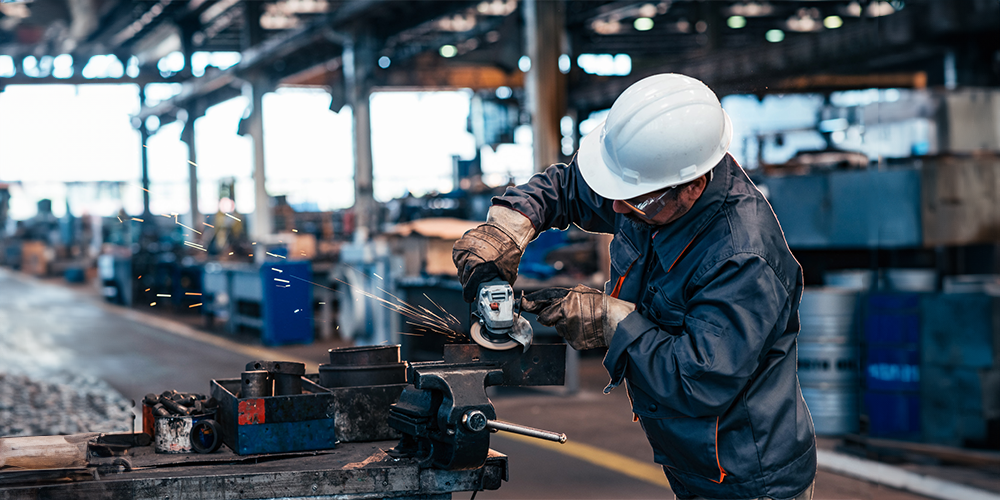Description
Copyright infringement not intended
Picture Courtesy: TeamLease
Context:
In the backdrop of global economic uncertainty, shifting geopolitical alliances, and trade disruptions, India is uniquely positioned to reposition itself as a major manufacturing hub. Prime Minister Narendra Modi's reinterpretation of Swadeshi — which emphasises "manufacture in India, regardless of brand origin" — marks a pragmatic and inclusive shift in industrial policy.
Emerging Trends
Global Turbulence as an Opportunity
- Rising global protectionism, tariff wars, and supply chain realignments (e.g. post-COVID, Ukraine war, US-China tensions) are pushing multinational firms to diversify production bases.
- India, with its large domestic market and improving infrastructure, offers a strategic alternative.
FDI and Manufacturing Momentum
- Recent announcements like Hyundai’s increased investment (₹11,000 crore) and Toyota’s ₹20,000 crore greenfield plant in Maharashtra show rising confidence in India as a manufacturing base.
- Maruti Suzuki’s success story—balancing domestic sales and exports—demonstrates the dual-market advantage of manufacturing in India.
Current Status of the Manufacturing Sector in India
- Growth in Manufacturing Output
- India’s manufacturing sector demonstrated steady growth and resilience, recording a 26% increase in output during FY 2024–25. According to the Index of Industrial Production (IIP), manufacturing remains the dominant contributor to industrial activity, accounting for approximately 77% of total industrial output. Industries such as basic metals, electrical equipment, and capital machinery were key drivers of this growth.
- Contribution to GDP and Government Goals
- Currently, the manufacturing sector constitutes around 17% of India’s Gross Domestic Product (GDP). To strengthen its industrial base and reduce dependency on imports, the government has set a target to raise this contribution to 25% by 2030. Flagship initiatives like ‘Make in India’ and ‘Atmanirbhar Bharat’ are central to this vision, focusing on enhancing productivity, generating employment, and improving India’s global competitiveness.
- Growth in Export-Oriented Manufacturing
- India’s manufacturing exports have shown positive momentum, increasing by 52% year-on-year, with total exports reaching USD 184.13 billion in the first five months of FY 2024–25. Sectors like electronics, pharmaceuticals, engineering goods, and automobiles have performed strongly, driven by rising global demand and targeted government incentives promoting exports.
- Trends in Foreign Direct Investment (FDI)
- India has emerged as a key destination for global manufacturing investments. Between 2014 and 2025, cumulative FDI inflows stood at USD 748.78 billion, marking a 143% increase over the USD 308.38 billion received during 2003–2014.
- In FY 2024–25 alone, India attracted USD 81.04 billion in gross FDI inflows, reflecting a 14% year-on-year increase. Notably, FDI in manufacturing rose by 18%, reaching USD 19.04 billion, compared to USD 16.12 billion in the previous year.
- Among states, Maharashtra accounted for the highest share of equity FDI inflows at 39%, followed by Karnataka (13%) and Delhi (12%), reaffirming their status as industrial and investment hubs.
Key Catalysts Driving India’s Manufacturing Surge
- Rapid Growth in Electronics Manufacturing
- Over the last 11 years, electronics production has grown sixfold, while exports have increased eightfold, positioning India as a global manufacturing hub.
- Domestic value addition in electronics manufacturing has risen from 30% to 70%, with a national target of 90% by FY 2026–27.
- India has become the second-largest mobile phone producer globally.
- Since FY 2020–21, the sector has attracted over USD 4 billion in FDI, reflecting investor confidence in India’s electronics ecosystem.
- Expansion of the Pharmaceutical Sector – "The Pharmacy of the World"
- India ranks third globally in pharmaceutical production by volume and 14th by value.
- It supplies about 50% of the global vaccine demand and 40% of generic drugs used in the US.
- Growth is driven by policy incentives such as:
- PLI Scheme for pharmaceuticals: ₹15,000 crore
- Strengthening of Pharmaceuticals Industry (SPI) scheme: ₹500 crore
- These interventions have reinforced India's role in the global pharmaceutical supply chain.
- Booming Automotive Industry
- The automotive sector contributes 7.1% to India’s GDP and 49% to manufacturing GDP.
- In FY 2024–25, total production reached 3.10 crore units across passenger vehicles, commercial vehicles, two-wheelers, three-wheelers, and quadricycles.
- India now stands as the fourth-largest automobile producer globally, with vast potential for value chain integration in international markets.
- Revival and Expansion of the Textile Sector
- As per the Economic Survey 2024–25, the textile and apparel industry contributes:
- 3% to GDP
- 13% to industrial output
- 12% to total exports
- The sector is projected to grow to USD 350 billion by 2030.
- Employing over 45 million people, it is the second-largest employment provider after agriculture.
- The government launched 7 PM MITRA Parks, backed by ₹4,445 crore, to boost integrated textile manufacturing by 2027–28.
- Rise of Digital Manufacturing and Industry 4.0
- A growing number of companies are adopting automation, AI, IoT, and big data to enhance quality and efficiency.
- AI adoption among Indian manufacturers rose from 45% in 2022 to 65% in 2024 (NASSCOM, MeitY).
- India now ranks 6th among the top 9 DeepTech ecosystems globally, according to NASSCOM data.
- The digital transformation is central to India’s strategy to leapfrog into advanced manufacturing.
- Push for Sustainability and Green Manufacturing
- Regulatory frameworks and market demand are encouraging investments in clean energy and sustainable production.
- A ₹24,000 crore PLI scheme has been launched to promote solar photovoltaic (PV) module production, with a projected capacity addition of 65 GW.
- These efforts align with global climate goals and enhance India’s competitiveness in green technologies.
- Skill Development and Workforce Modernisation
- Government initiatives like PM Kaushal Vikas Yojana (PMKVY) are training youth in areas such as robotics, AI, and IoT, aligning with Industry 4.0 requirements.
- India generated over 17 crore jobs in the last decade, supporting the Viksit Bharat (Developed India) vision.
- As per PLFS data (August 2025):
- Worker Population Ratio (WPR):2%
- Female Labour Force Participation Rate (LFPR): Rose to 33.7%
- Unemployment Rate (UR): Declined to 5.1% overall, and to 5.0% for men
- Manufacturing-specific employment rose from 6% during 2004–2014 to 15% in the last decade, indicating a major improvement in job creation.
Policy Frameworks Accelerating India’s Manufacturing Sector
- National Manufacturing Mission (NMM)
- Announced in the 2025–26 Union Budget, the NMM brings together policy, implementation, and oversight across central ministries and state governments.
- Priorities include sustainable technologies—such as solar photovoltaic modules, electric vehicle (EV) batteries, green hydrogen, and wind turbines.
- It aims to shift India from modest growth to global manufacturing leadership, in line with the country’s net-zero by 2070 goals.
- Goods and Services Tax (GST) Reforms
- Simplified structure under “GST 2.0” with fewer slabs, easing compliance burdens for manufacturers.
- Lower rates (around 5%) for goods like packaging, textiles, leather, wood, and logistics essentials, helping reduce production costs and improve export competitiveness.
- Particular support for MSMEs and export-driven industries—via rationalised rates and quicker refunds—especially in textiles, food processing, handicrafts, toys, and leather.
- Reduced GST on trucks, delivery vans, and auto components boosts both demand and the efficiency of supply chains in freight-heavy sectors.
- Make in India & Production Linked Incentive (PLI) Scheme
- Make in India, initiated in 2014, has the goal of increasing manufacturing’s share of GDP from ~17% to ~25%, with a focus on sectors like electronics, automotive, defense, and textiles.
- The PLI Scheme, launched in 2020 across 14 priority sectors (e.g., electronics, mobile phones, pharmaceuticals, textiles, drones), offers incentives tied to incremental production and sales.
- With a total outlay of around ₹1.97 lakh crore, PLI aims to scale up capacity and enhance India’s competitiveness in global markets.
- National Logistics Policy (NLP) & Related Reforms
- Launched in September 2022, the NLP seeks to cut logistics costs, lift efficiency, and push digital integration.
- The Comprehensive Logistics Action Plan (CLAP) includes measures such as standardisation, developing logistics parks, improving human resources, strengthening coordination between states, and enhancing multi-modal transportation links.
- Aspirational goal: placing India among the top 25 in the World Bank’s Logistics Performance Index by 2030.
- Startup India & Innovation Ecosystem
- Startup India, since its inception in 2016, has nurtured entrepreneurship and job creation.
- As of 9 September 2025, India has about 191,000 DPIIT-recognised startups, which have created over 1.76 million (17.69 lakh) direct jobs by 31 January 2025.
- These startups drive innovation, especially in cutting-edge manufacturing technologies and value-added services.
- Industrial Corridors and Strategic Hubs
- The National Industrial Corridor Development Programme promotes purpose-built, integrated industrial cities (often under the Smart Cities framework), linked by multi-modal transport alternatives to back manufacturing growth.
- Last year, 12 new projects were approved under this programme, with investment commitments of approximately ₹28,602 crore.
- The proposed Development of Enterprises and Strategic Hubs (DESH) Bill seeks to streamline processes—such as approvals—improve infrastructure, and extend incentives to enterprises operating in these corridors.
Challenges
- Low Domestic Value Addition in Electronics Sector: While smartphone assembly has risen, deep-level manufacturing and component ecosystems are still underdeveloped.
- Policy Consistency and Predictability: Investors need clarity on taxation, labour reforms, and export incentives. Sudden policy changes deter long-term commitments.
- Skilling and Labour Market Flexibility: India needs a skilled workforce for high-tech manufacturing. The gap between demand and availability of skills persists.
- Supply Chain Ecosystem: Ancillary industries and MSMEs need support to integrate into the supply chain of large manufacturers.
- Limited Financial Access for MSMEs: MSMEs face difficulty accessing affordable credit; working capital shortages are common.
- Global Competition and Innovation Deficit: Competing with low‐cost manufacturing hubs (like Vietnam, Bangladesh, China) puts pressure on prices and margins.
- Environmental & Sustainability Pressures: Manufacturing is resource‑intensive. India must balance industrial growth with constraints on water, energy, and emissions.
- Meeting its net‑zero by 2070 commitment involves costs: shifting to clean energy, adopting green processes, complying with stricter environmental norms.
- Non‑tariff barriers such as strict safety, environmental, and quality standards in importing countries make it harder to access markets.
International Best Practices
- Adopting Lean Manufacturing and Quality Systems
- Countries like Japan and Germany have long embraced Lean Manufacturing and Six Sigma practices to enhance operational efficiency.
- These systems focus on reducing waste, improving quality, and increasing productivity.
Lesson for India: Promoting lean manufacturing practices—especially among MSMEs—can improve cost-efficiency and product quality, aligning Indian goods with global standards.
- Accelerating Industry 4.0 Integration: Nations like China and the United States are global frontrunners in smart manufacturing, using technologies such as:
- Advanced robotics
- Big data analytics
- Artificial Intelligence (AI)
- Internet of Things (IoT)
- Lesson for India: While India is making progress—particularly in the auto and electronics sectors—scaling up automation and digital adoption across more industries will be key to global competitiveness.
- Building Resilient Supply Chains
- China’s multi-sourcing approach and contingency planning have helped reduce supply disruptions during global crises.
- China also leverages domestic manufacturing ecosystems to cushion against international shocks.
- Lesson for India: Diversify sourcing, build inventory buffers, and invest in local value chains to reduce dependence on single-country suppliers.
Way Forward
- Reinforce PLI Schemes with Clear Exit Clauses: Provide time-bound incentives with transparency to encourage large-scale investment.
- Boost Domestic Value Chains: Support backward integration in sectors like electronics, semiconductors, and defence manufacturing.
- Focus on Logistics and Trade Facilitation: Speed up port connectivity, warehousing, and digital clearance mechanisms to boost exports.
- Attract Investment via Demonstration Effect: Use successful cases (Maruti, Apple, Hyundai) as templates to attract more investors.
- Incorporate Swadeshi 2.0 into National Industrial Policy: Build a cohesive vision that merges global participation with domestic value creation.
Source: Indian Express
|
Practice Question
Q. "Turbulent global conditions offer India an opportunity to emerge as a reliable manufacturing hub."
Analyse this statement with reference to India's FDI trends, infrastructure development, and policy support. (250 words)
|
Frequently Asked Questions (FAQs)
- Electronics (especially mobile phones)
- Pharmaceuticals ("Pharmacy of the World")
- Automobiles
- Textiles
- Engineering goods and capital machinery
- Digital manufacturing (AI, robotics, IoT)
As of FY 2024–25, the manufacturing sector contributes approximately 17% to India's GDP.
Launched in Budget 2025–26, the NMM aims to:
- Integrate policy across ministries and states
- Promote green manufacturing (solar PV, EV batteries, wind, hydrogen)
- Align India’s industrial goals with its Net-Zero 2070 commitment
Transition from incremental to transformational growth








